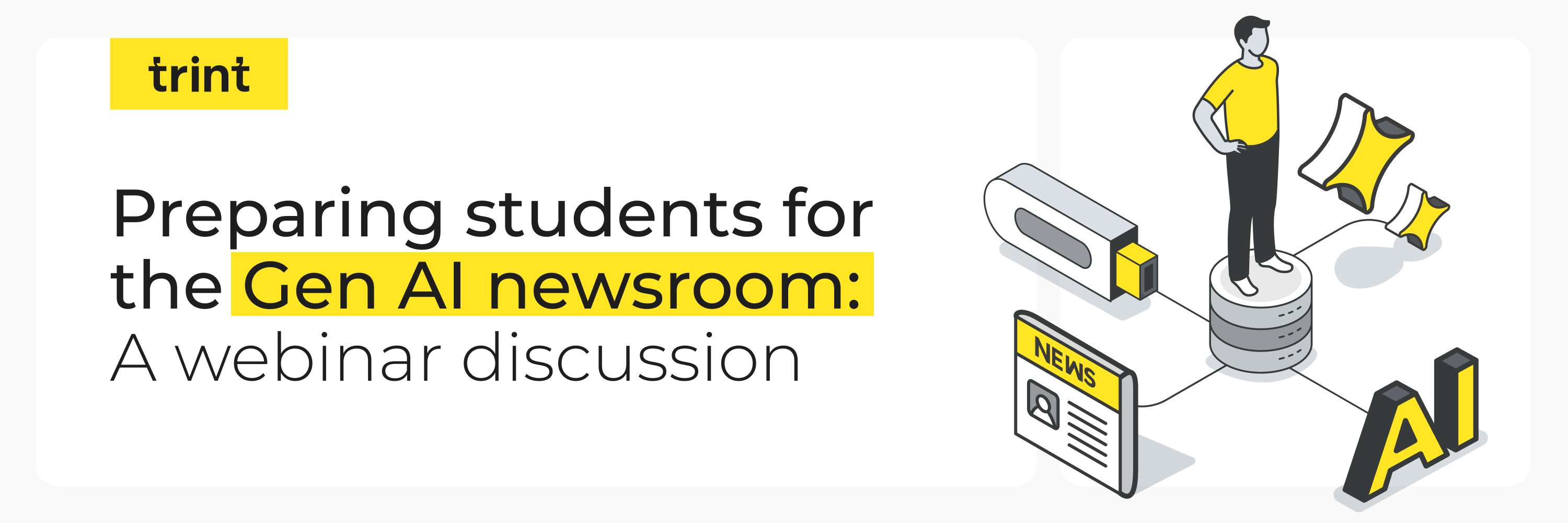
We recently spoke with Rob Lang, Newsroom AI Editor at Thomson Reuters, to understand how generative AI is transforming newsroom roles and skills - and how newsrooms can better prepare talent for the future newsroom.
It's clear that generative AI (gen AI) is disrupting the newsroom. By automating lower value tasks from transcription and translation through to large-scale information discovery and analysis, newsrooms are banking on gen AI to supercharge efficiency gains that keep them ahead of the pack.
But what impact is generative AI having on roles and competencies within the newsroom? And how do we equip emerging talent for the new realities of the AI newsroom?
We were fortunate enough to put these questions to Rob Lang, AI Newsroom Editor at Thomson Reuters. A media veteran whose career spans 30 years, Rob recently took on a newly-created role dedicated to AI implementation in the newsroom. While such a role was likely unimaginable only three years ago, it feels like this is where newsrooms are heading, and fast. “Most organizations are going to need someone to look after (AI) to make sure that the right tools are being used”, Rob predicts.

Ask most newsroom teams and they’ll likely suggest that journalists and technology teams have traditionally operated in separate silos. And that needs to change. “What we really need is to have the technologists and the journalists so close together”. Rob adds: “What's really important - and what I'm really going to be focusing on in my role - is making sure that journalists and developers are no longer separated”.
A week prior to chatting with Trint, Rob successfully ran his first AI hackathon in his new role where he brought together both journalists and technical people within Thomson Reuters to come up with new ideas on how to solve existing newsroom challenges.
And the closer the convergence gets, the more likely we can expect to see new roles and competencies entering the newsroom very soon (if not already. "I really do see one of the roles of the future - and I'm still trying to think of the name of the journalist coder - but the best one I've come up with so far is ‘hack scribe’", comments Rob offering an intriguing glimpse into the future, before discussing likely roles such as:
If Rob’s new role is anything to go by, expect to welcome someone who’ll be responsible for transforming experimental AI ideas into production-ready editorial solutions - all while maintaining journalistic integrity. They will likely focus on: editing and refining AI prompts; overseeing AI training for the team; and developing best practices and guidelines to safeguard quality and ethical compliance across all AI implementations.
As Rob puts it, they’ll serve as the bridge between technology and journalism. “My role is largely to represent technology to editorial, and to represent editorial to technology.”
Newsrooms can also expect to hire for a dedicated Journalism Prompt Editor or Engineer - that is, someone who can effectively “prompt” or guide generative AI models and Large Language Models (LLMs) to produce desired outcomes.
While such a role might sound far from the realms of traditional journalism, Rob suggests that anyone who can learn to be a journalist can also learn the art of great prompting. “I think they're actually very similar skills”. Rob continues: “It's about being able to write very clearly and very specifically … so it's about understanding the task in hand and describing it accurately, which is very similar to reporting”.

With gen AI reshaping tasks, roles and competencies, how should we approach not just reskilling current newsroom talent but also preparing the next generation so that they enter the AI newsroom ready to thrive?
The time seems ripe for a rethink in how journalism schools prepare students for an AI-augmented future, and our conversation with Rob surfaced three potential paths forward:
But what cannot be compromised in this rethink is fostering the ability to think critically. A big part of moving away from assignment-based assessments and back towards examinations stems from not losing critical thinking as a competency. “This is the really important thing. We can't lose critical thinking as a skill, and we need to teach people how to do critical thinking", Rob reasons, before adding: “There probably is a danger that people will think ‘well I don't have to think now because the AI will do it for me’”.

Whether it’s the AI Newsroom Editor, Prompt Engineer or even “Hack scribe”, generative AI is giving rise to new positions entering the newsroom. The key for newsrooms and educators alike will be to embrace this transformation while safeguarding the critical thinking skills that remain irreplaceable. After all, in a world where AI can generate content at scale, the ability to question, verify, and contextualize information becomes more valuable than ever.
